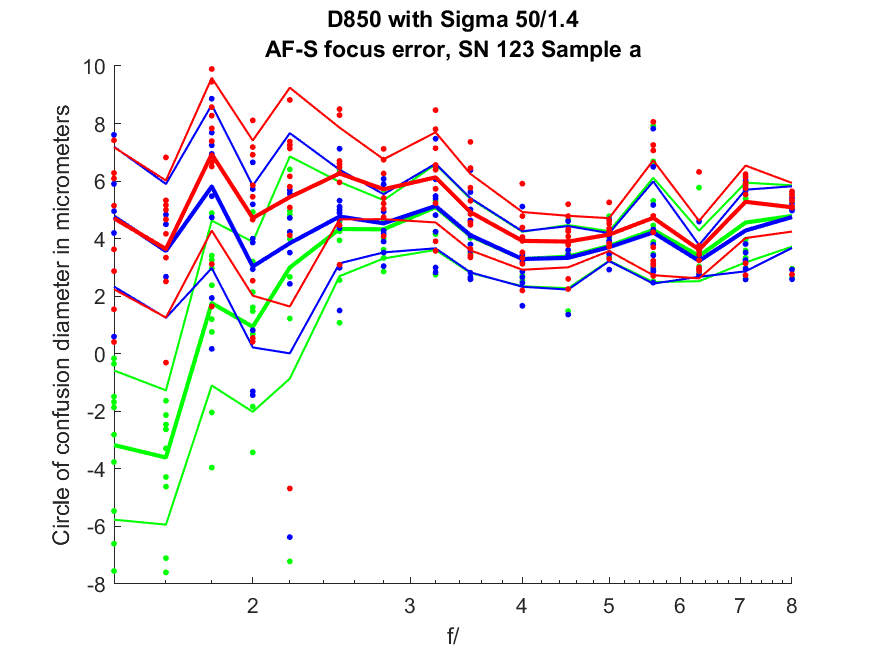This is a continuation of a series of posts on the Nikon D850. You should be able to find all the posts about that camera in the Category List on the right sidebar, below the Articles widget. There’s a drop-down menu there that you can use to get to all the posts in this series; just look for “D850”.
A reader in another venue reacted to the autofocus testing that I’ve been doing with disdain, saying that my results were quite different from what he had learned just using the D850 and that my methods were flawed because I only tested one sample of each lens and each camera.
You will not be surprised to know that this criticism did not shake my faith in quantitative, sample-space-of-one, testing and cause me to start writing lens tests that sounded like they could have been written by Robert Parker. But it did cause me to think. I’ve got two copies of the Sigma 50 mm f/1.4 ART lens in Nikon F mounts. Let me introduce you. Their full serial numbers are pretty long, so I’ll just identify them by the last three digits, “123” and “370”. They were shipped on the same day from different sources (don’t ask), so they are of the same production vintage.
I thought that it might be interesting to see how they compared to each other. I took a leaf from the winetasting handbook, and ran the equivalent of a triangle tasting, which presents the tester three unmarked glasses, two of which contain the same wine, and asks for a description of each sample.
First I ran the focus shift tests, twice on hardworking 123, and once on lazy 370. Here’s what happened (we’re not doing this blind):
I’ve plotted the three Adobe RGB color channels. The graph presents displacement of the image projected on the sensor from the desired green-channel focal plane. Negative numbers indicate front-focusing. The image-plane shift is in micrometers (um). The separation of the focal distances of the three color planes is because of the longitudinal chromatic aberration (LoCA) of the lens. The dots indicate the results for each of the ten exposures at each f-stop. I’ve made lines indicating the average (aka mean or mu) of the sample set bolder and added thin lines above and below the means that are one standard deviation (sigma) away from it. There are differences between the two runs with lens 123, but they are small, especially at the endpoints, compared to the differences between the two 123 plots and the 370 one. 370 has more focus shift.
But when we look at the circles of confusion (CoCs) implied by the above graphs, we can see just how similar these lenses are:
With 123, the green channel CoCs are at worst about a pixel pitch and a half. With 370, they are are approaching 3 pixel pitches.
Now let’s look at the performance when we turn on spot AF-S, with AF Adjust set to 0:
You can see that 370 needs a different AF adjust setting from 123. However, the general behavior of the two lenses is much the same.
Here’s what 370 looks like with an AF adjust of +10:
I’ll just plot one of the CoC curves:
Within two pixel pitches for the means plus and minus one sigma. With the right lens and AF tuning, the D850 can turn in some great on-axis AF performances. We saw problems off-axis with the Sigma 135/1.8, though. I wonder if there is anything similar going on with the 50 ART.











Forget the off-center focus testing, you will open a can of worms and it is to cold to go fishing.
Most of the lenses faster or equal to f2.8 will backfocus using the last two side rows.
Some times the backfocus will be tolerable, some times will be much like you observed testing the 135 Sigma.
Nikon focus module is seldom simmetric: one side will backfocus more than the other.
I hoped they solved this issue but both my D500 and D850 have it.
Thom Hogan said to me , in one email , that the module lateral gates probably receive wrong optical informations if you use fast lenses.
My bests
Livio
PS
Ofcourse I really hope to be wrong and that the previous statements are only fiction.